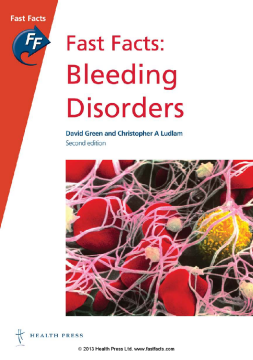
Additional Information
Book Details
Abstract
Most hemorrhagic problems are emergencies, requiring rapid diagnosis and prompt management to stop bleeding. In some cases, such as nose bleeds, large bruises and heavy menses, it is the clinician’s responsibility to discern whether the patient has a clinically significant bleeding disorder that may predispose to excessive or potentially serious bleeding. Fast Facts: Bleeding Disorders keeps a complex subject simple and clinically oriented. The authors have made numerous updates to this second edition to ensure it provides essential information in a readily accessible format. Highlights include:
- An expert overview of normal hemostasis
- A clear assessment pathway, from taking an accurate history and focused clinical examination, to essential laboratory investigations
- Objective criteria for diagnosing hereditary hemorrhagic telangiectasia
- The latest guidelines on diagnosing and treating primary immune thrombocytopenia
- A discussion of the benefits of prophylaxis in patients with hemophilia
- Updated methods for evaluating and treating bleeding disorders in pregnancy
- An overview of the scoring system for disseminated intravascular coagulation
- Information on the latest anticoagulants and antithrombotics, including bleeding risks and strategies to control bleeding.
Fast Facts: Bleeding Disorders remains a comprehensive up-to-date reference that reflects the latest research and clinical guidelines. It will assist primary care providers, physician assistants, nurse-clinicians, pharmacists, residents and doctors in training as they confront the challenges of controlling bleeding in patients with hemophilia, von Willebrand disease, platelet disorders and thrombosis, or as a result of antithrombotic or anticoagulant therapy. It is a small book packed with important information, designed to swiftly improve patient treatment and outcomes.
This concise and broad overview of pertinent clinical issues in hemostasis and thrombosis is a quick reference guide for seasoned and novice clinicians alike. The authors accomplish their purpose of providing short, concise, evidence-based reviews of a variety of bleeding disorders and hemorrhagic conditions in an easily accessible format. This kind of book is important to medical providers in different stages of training and clinical practice. The authors have written this book for physicians, physician assistants, nurse practitioners, and pharmacists. The audience can be broadened to include all allied health professionals who will find this book to be an easy read and ready resource for quick reference … The chapter on the mechanism of action and management of bleeding caused by recently approved anticoagulants is especially helpful … This is an excellent book that will be very useful to both trainees and seasoned clinicians. (Numerical weighted score: 100 - 5 stars!)
Oluwatoyosi A. Onwuemene, MD
